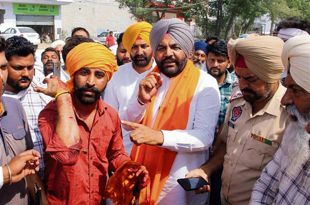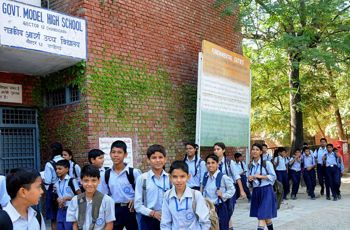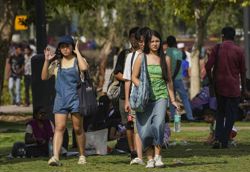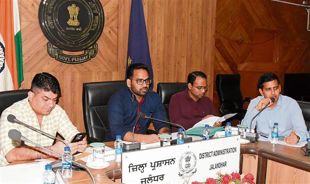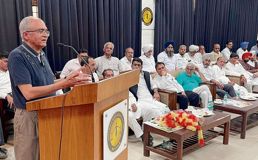
From washrooms to refreshment stalls, there are umpteen facilities along the long track to the shrine to make the journey of the faithful comfortable. Tribune photos: Inderjeet Singh
Arteev Sharma
Every spirited incantation of “Jai Mata Di”, the faithful believe, gives their upward climb to seek the Goddess’ blessings a push. The pilgrims’progress has also been helped a great deal by the way the 13-km arduous trek to the Vaishno Devi cave-shrine in Trikuta Hills of Katra, near Jammu, has been made easier over the years.
Undertaken by nearly 1 crore pilgrims from across India and abroad every year, the pilgrimage has become a role model of sorts for shrine management. That there’s been no instance of a stampede at the shrine or along the yatra route is one aspect, the bigger one is the kind of facilities offered.
Notwithstanding the substantial incre-ase in the number of pilgrims — up from 13.96 lakh in 1986 — the Shri Mata Vaishno Devi Shrine Board (SMVDSB) has ensured the smooth conduct of the yatra each year.
Before the constitution of the board in 1986, the track to the holy cave was not concrete and there was no facility of electricity and water for pilgrims. Considering that nearly 14 lakh pilgrims would pay obeisance then, the government felt the need to manage the shrine better and offer facilities to pilgrims.
Over the past few years, the board has taken a giant leap in infrastructural development at Katra (pilgrimage base camp), along the yatra track and the main bhawan to make the stay of pilgrims comfortable. It reinvests offerings and donations in improving facilities. To end the cumbersome registration process at the base camp, the board introduced online registration for pilgrims, besides setting up multiple counters for speedy registration.
Assuming social responsibility
 Apart from ensuring a pleasant pilgrim experience, the board — chaired by Jammu and Kashmir Governor NN Vohra — has been providing support to various development, cultural, education and healthcare activities in the region. From time to time, it has also helped in the construction of school buildings and infrastructure.
Apart from ensuring a pleasant pilgrim experience, the board — chaired by Jammu and Kashmir Governor NN Vohra — has been providing support to various development, cultural, education and healthcare activities in the region. From time to time, it has also helped in the construction of school buildings and infrastructure.
Under the board’s social responsibility scheme, says Mandeep Kumar Bhandari, Chief Executive Officer of the shrine board, financial support has been extended to students in the form of scholarships. Weddings of women belonging to the erstwhile Baridar families are also solemnised, besides supporting self-help groups of locals and the Baridar community.
Other than this, the board has also been supporting the translation of Dogri literary works into English and Hindi and publication of eight editions of Dogri comics.
The board runs the Mata Vaishno Devi Gurukul to impart the knowledge of Sanskrit and Vedic culture through scriptures. Karma Kanda — ritual services by Brahmins in exchange for bhiksha — are also held on the campus. However, it is not only about Vedic science, the students are also taught English, mathematics, science, social studies, computer sciences and music.

Apart from religious significance, the pilgrimage, with an annual contribution of around Rs 500-550 crore, has given an impetus to the local economy. The annual offerings and donations at the shrine range between Rs 100 crore and Rs 110 crore, which is pumped back in to improve facilities and upgrade infrastructure.
The board has a workforce of 2,500, including 750 safai karamcharis. There are about 500 hotels and lodges in Katra, making it possible to accommodate nearly 30,000 pilgrims every day. The influx of pilgrims is expected to go up even more with the introduction of direct trains to Katra. In July last year, Prime Minister Narendra Modi had flagged off the train service, linking Katra with the rest of the country. The stakeholders of pilgrimage tourism, however, are not satisfied with the progress on the extension of some important trains to Katra.
While locals give credit to the board for the all-round development of Katra and its periphery, they complain of the casual attitude of successive governments in setting up basic facilities for pilgrims. Traffic congestion is also a major concern as it has burdened the already stretched parking space in the town. Thousands of vehicles enter Katra every day.
A lot done, but this stretch of the highway to Katra is a reality too
 ‘Tough 5-km stretch on national highway’
‘Tough 5-km stretch on national highway’
The nearly 5-km stretch on the Katra-Domail National Highway is in a poor state, making it tough for pilgrims visiting Katra. The executing agency has left the road-widening project midway. The government should hold an inquiry into the project delay. — Ashwani Kumar, a shopkeeper at nomain
‘No new trains yet’
Eight months have passed since the Prime Minister announced the extension and introduction of trains to Katra, but nothing has been done so far. Pilgrims continue to face inconvenience due to the failure of the railways to run more trains to Katra. — Rakesh Wazir, senior vice-president, Katra hotel and lodges association
Dos and don’ts for Vaishno Devi pilgrimage

- Before proceeding for the trek, obtain the yatra slip (free of cost) from the registration counter near the Katra bus stand. Jammu airport, Katra and Jammu railway stations. Niharika, Katra taxi stand and Katra helipad also have registration counters
- Book rooms with the Enquiry and Reservation Counter at Niharika Complex near the Katra bus stand to avail facility of rented accommodation at Katra, Adkuwari, Sanjichhat or Bhawan
- Confirm rates of porters, ponies and palanquins before hiring them. Ensure they carry a valid registration card
- Cooperate with security agencies for security checks along the track
- Don’t trust strangers with belongings. Deposit excess baggage at cloak rooms
- Don’t eat anything offered by strangers
- Obtain the group number at the yatra slip checkpost to get into queue for darshan
- While inside the sanctum sanctorum, focus on the holy Pindis of the Goddess. It is easy to miss these in the rush
Majority of porters Muslims
Amit Khajuria
Even as the shrine caters to lakhs of pilgrims every year, it also provides employment to thousands from every nook of the state.
 The Vaishno Devi pilgrimage is a model of communal brotherhood. Nearly 70 per cent of around 30,000 porters, who earn their livelihood as palki-bearers, pithu carriers and pony-wallahs, are Muslims.
The Vaishno Devi pilgrimage is a model of communal brotherhood. Nearly 70 per cent of around 30,000 porters, who earn their livelihood as palki-bearers, pithu carriers and pony-wallahs, are Muslims.
Over time, thousands of Muslim labourers have developed a sense of faith in the cave-shrine, which they visit twice a month. Mohammad Shabir, 35, from Rajouri district, has been working as a palki-wallah for 15 years. He believes that the strength of trudging on this track with extra load is only possible because of the blessings of the Goddess. “Though it is a Hindu shrine, I have strong faith in the Goddess. This shrine has bestowed a lot on me and my family,” he says. “It not only provides us with livelihood, but also gives us the strength to carry the burden that we do.”
Nineteen-year-old Mohammad Gulzar, who became a porter two years ago, says, “We have never felt that we are from another religion. I used to pay obeisance at the shrine and all my wishes have come true.”
These labourers, who come from Poonch, Rajouri and Reasi, buy bamboo, chairs and ropes to make a palki to carry pilgrims from the base camp at Katra to the shrine. They charge Rs 4,500 for a to-and-fro journey from Darshani Deodi near Banganga to the bhawan and Bhairon Ghati. The rates are fixed by the board.
LEGEND HAS IT...
- It is not possible to ascertain when the pilgrimage actually started. A geological study of the holy cave has indicated its age to be nearly a million years. Vedic literature gives no reference to the worship of any female deity, although Trikuta mountain finds mention in the Rigveda, the oldest of the four Vedas. ‘Shakti’ worship largely began in the Puranic period. The first mention of Goddess Vaishno Devi is in the Mahabharata. Vaishno Devi or Vaishnavi is a manifestation of Goddess Durga.
- There are various versions of the origin and legend of Mata Vaishno Devi, but there seems to be unanimity on the discovery of the shrine around 700 years ago by Pandit Shridhar. Legend has it that it was at his place that the Mata had helped organise a bhandaara. When she fled during the bhandaara to escape from Bhairon Nath, Pandit Shridhar is said to have felt as if he had lost everything. He gave up the intake of food and water, fervently praying for Vaishnavi to reappear. It is then that she appeared in his vision and told him to search for her at the holy cave situated amid the folds of Trikuta.
With time, facilities have only gotten better
Pilgrims who visit the shrine often are amazed at the development that has taken place at the shrine, facilitating their onward journey.
 Sudershan Juneja, aged 72, has been visiting the shrine since 1967, when there was no proper lighting arrangement and no concrete track to reach the shrine. “I remember those days, when the track was kutcha. We would carry a torch and eatables as there were hardly any food stalls along the track or near the bhawan,” she recalls.
Sudershan Juneja, aged 72, has been visiting the shrine since 1967, when there was no proper lighting arrangement and no concrete track to reach the shrine. “I remember those days, when the track was kutcha. We would carry a torch and eatables as there were hardly any food stalls along the track or near the bhawan,” she recalls.
“The shrine board has not only provided a wide and smooth track for the yatra, but also made sufficient arrangements for washrooms, food courts on a no-profit, no-loss basis, rooms, dormitories, cloak rooms and bathing ghats.We hardly find garbage or litter on the track,” she adds.
Kala Khan, a 45-year-old potter who has been working here for 25 years, says, “Other shrines should learn a lesson from the board here on how to manage, maintain and develop a shrine, and also, utilise funds for the development of society.”
“Earlier, only young and physically fit pilgrims would go on foot, all others would take a pony ride. But now, pilgrims have many options to reach the bhawan. The board has also started a helicopter service. Battery cars are also available to make the yatra easier and comfortable,” he adds. — Amit Khajuria
Facilities coming up at cave-shrine
 |
| Shrine board chairperson NN Vohra takes stock of the facilities at the bhawan. |
Shrine ropeway
The Shri Mata Vaishno Devi Shrine Board is working on a passenger ropeway between the bhawan and Bhairon Temple and a material ropeway between Siar Dabri and the bhawan. CEO Mandeep Kumar Bhandari says the 375-m passenger ropeway would cost Rs 55 crore and the material ropeway Rs 10 crore. The work is scheduled to be completed this year.
Multi-specialty hospital
Shri Mata Vaishno Devi Institute of Medical Excellence, a 230-bed multi-specialty hospital, will become operational next year. It is coming up at Kakryal village near Katra. The project was conceived as a cancer hospital, but the board decided on a multi-specialty hospital. The hospital would benefit patients of J&K and neighbouring states. It is being equipped with state-of-the-art equipment.
Katra-Adh Kunwari track
Considering the increased influx of pilgrims and the inconvenience they face due to the movement of ponies, as also the congested track between Katra and Adh Kunwari, the board is constructing another track. Called the New Katra-Adh Kunwari track, the 7-km stretch will be out of bounds for ponies. The new track will be wider and easier to negotiate because of the uniformity of climb and lower gradient.
Hi-tech nursery
During the past five years, the board has planted 13 lakh saplings on Trikuta Hills. It has also started raising in-house plant stock, for which it has set up a hi-tech nursery near Panthal. It would have the capacity to grow 5 lakh plants a year.
Multipurpose sports stadium
Being constructed at Katra at a cost of Rs 10.76 crore, it would facilitate the organisation of mega sports events at state and national levels.
Emergency announcements
The board is working on a project to provide linkage for the functioning of important services like CCTV cameras, LAN and EPABX, and making public announcements in case of an emergency. — Devinder Thakur





















